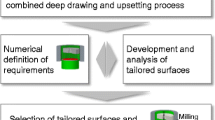Abstract
Surface structures are used for several applications in industry to enhance the characteristics of surfaces and therefore processes. One example is the Sheet-bulk metal forming process which combines the advantages of bulk and sheet metal forming. Due to the complex material flow and load, the tool surfaces do need adapted tribological properties. High feed milled surface structures have been used in the past to control the material flow of the sheets. But due the high stresses appearing, the surfaces show a running-in behavior which altereds the tribological conditions. Within this study, a pressurized air wet abrasive jet machining (PAWAJM) process is used for adapting the high feed milled surface in order to manipulate the tribological conditions. Therefore, the surfaces characteristics, residual stresses as well as the tribological effects were investigated. It is shown that the PAWAJM process can be used to modify the surface characteristics and thus the friction of the surface. In addition, it can be seen that residual compressive stresses are applied during the PAWAJM.








Similar content being viewed by others
References
Kleiner M, Geiger M, Klaus A (2003) Manufacturing of lightweight components by metal forming. Ann CIRP 52(2):521–542
Mori K, Nakano T (2016) State-of-the-art of plate forging in Japan. Prod Eng Res Devel 10(1):81–91
Merklein M, Allwood JM, Behrens BA, Brosius A, Hagenah H, Kuzman K, Mori K, Tekkaya AE, Weckenmann A (2012) Bulk forming of sheet metal. Ann CIRP 61(2):725–745
Löffler M, Schulte R, Freiburg D, Biermann D, Stangier D, Tillmann W, Merklein M (2018) Control of the material flow in sheet-bulk metal forming using modifications of the tool surface. Int J Mater Form 52(2):1–10
Freiburg D, Löffler M, Merklein M, Biermann D (2017) Surface structuring of forming tool surfaces by high-feed milling. In: Schmitt R, Schuh G (eds) 7. WGP-Jahreskongress Aachen, 5.-6. Oktober 2017. Apprimus Wissenschaftsverlag, Aachen, p 63–70
Abele E, Dewald M, Heimrich F (2010) Leistungsgrenzen von Hochvorschubstrategien im Werkzeug- und Formenbau. Werkzeug und Formenbau 105:737–743
Zabel A, Surmann T, Peuker A (2008) Surface structuring and tool path planning for efficient milling of dies. In: Seventh international conference on high speed machining, p 16
Pilz F, Gröbel D, Merklein M (2018) Investigation of fatigue strength of tool steels in sheet-bulk metal forming. In: Proceedings of the 21st international ESAFORM conference on material forming: ESAFORM, p 160022
Denkena B, Biermann D (2014) Cutting edge geometries. CIRP Ann Manuf Technol 63:631–653
Bouzakis K-D, Skordaris G, Michailidis N, Asimakopoulos A, Erkens G (2005) Effect on PVD coated cemented carbide inserts cutting performance of micro-blasting and lapping of their substrates. Surf Coat Technol 200:128–132
Bouzakis K-D, Bouzakis E, Skordaris G, Makrimallakis S, Tsouknidas A, Katirtzoglou G, Gerardis S (2011) Effect of PVD films wet micro-blasting by various Al2O3 grain sizes on the wear behaviour of coated tools. Surf Coat Technol 205:128–132
Biermann D, Aßmuth R, Schumann S, Rieger M, Kuhlenkötter B (2016) Wet abrasive jet machining to prepare and design the cutting edge micro shape. Procedia CIRP 45:195–198
Mohlfeld A (2000) Trockenbohren mit PVD-beschichteten Hartmetallwerkzeugen. PhD Thesis, Leibniz University, Hannover
Terwey I (2011) Steigerung der Leistungsfähigkeit von Vollhartmetallwendelbohrern durch Strahlspanen. PhD Thesis, Technische Universität Dortmund, Vulkan Verlag, Essen
Harada Y, Fukaura K (2008) Influence of shot peening on surface characteristics of high-speed steels. Int J Mod Phys B 22(31n32):6094–6099
Montgomery Douglas C (2010) Design and analysis of experiments, minitab manual, 7th edn. Wiley, Oxford
Wagner T (2013) Planning and multi-objective optimization of manufacturing processes by means of empirical surrogate models. Vulkan (Schriftenreihe des ISF), Essen, p 71
Sedlaček M, Vilhena L, Podgornik MS, Vižintin B J (2011) Surface topography modelling for reduced friction. SV-JME 57(09):674–680
Bouzakis K-D, Klocke F, Skordaris G, Bouzakis E, Gerardis S, Katirtzoglou G, Makrimallakis S (2012) Influence of dry micro-blasting grain quality on wear behaviour of TiAlN coated tools. Wear 271(5–6):783–791
Vöhringer O (1978) Changes in the state of the material by shot peening. Conf Proc ICSP 3:185–204
Klocke F (2013) Manufacturing processes: forming. Springer, Berlin
Acknowledgements
This work was supported by the German Research Foundation (DFG) within the scope of the Transregional Collaborative Research Centre on sheet-bulk metal forming (CRC/TR 73, Subprojects B3 and C1).
Author information
Authors and Affiliations
Corresponding author
Rights and permissions
About this article
Cite this article
Freiburg, D., Aßmuth, R., Garcia Carballo, R. et al. Adaption of tool surface for sheet-bulk metal forming by means of pressurized air wet abrasive jet machining. Prod. Eng. Res. Devel. 13, 71–77 (2019). https://doi.org/10.1007/s11740-018-0858-4
Received:
Accepted:
Published:
Issue Date:
DOI: https://doi.org/10.1007/s11740-018-0858-4




